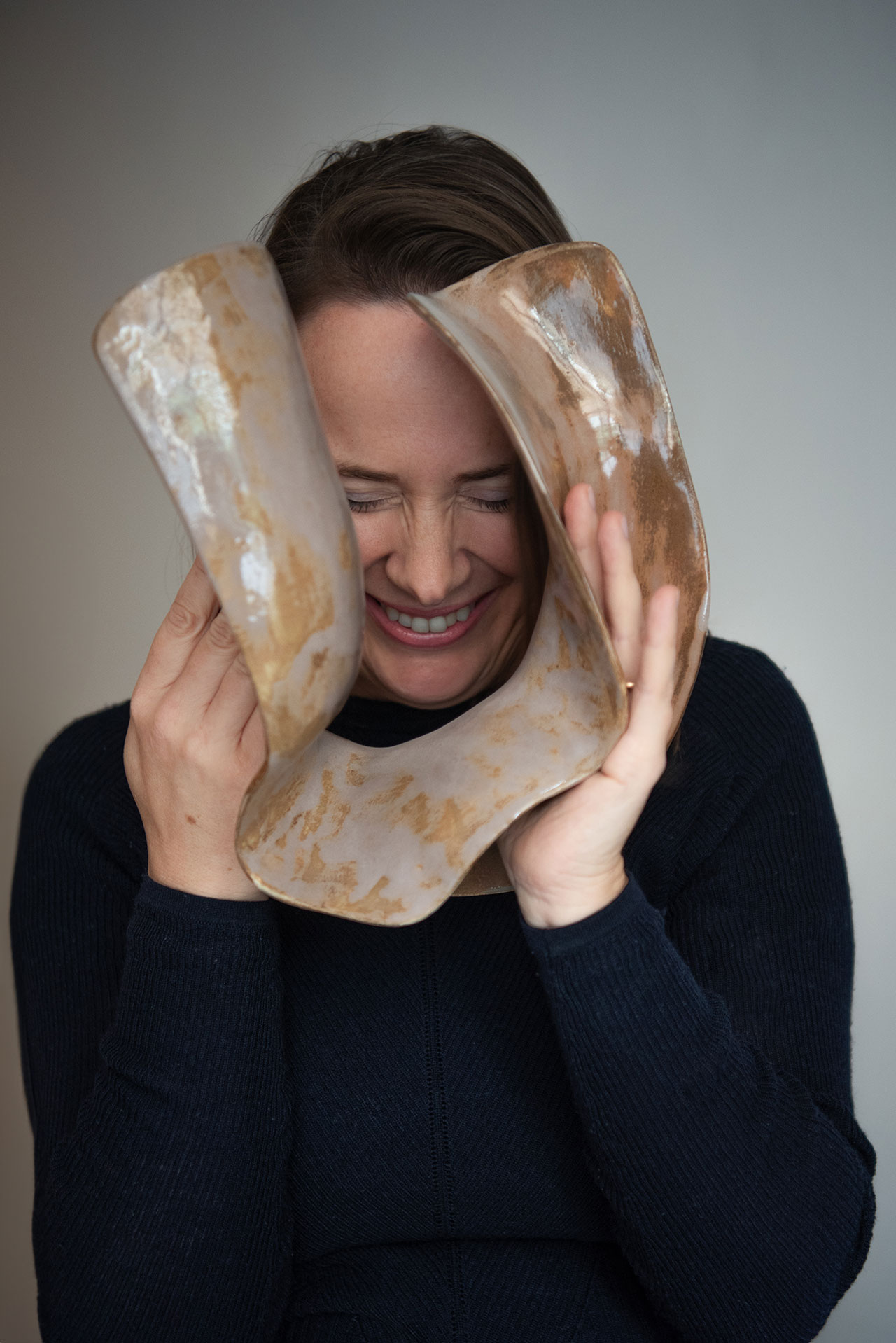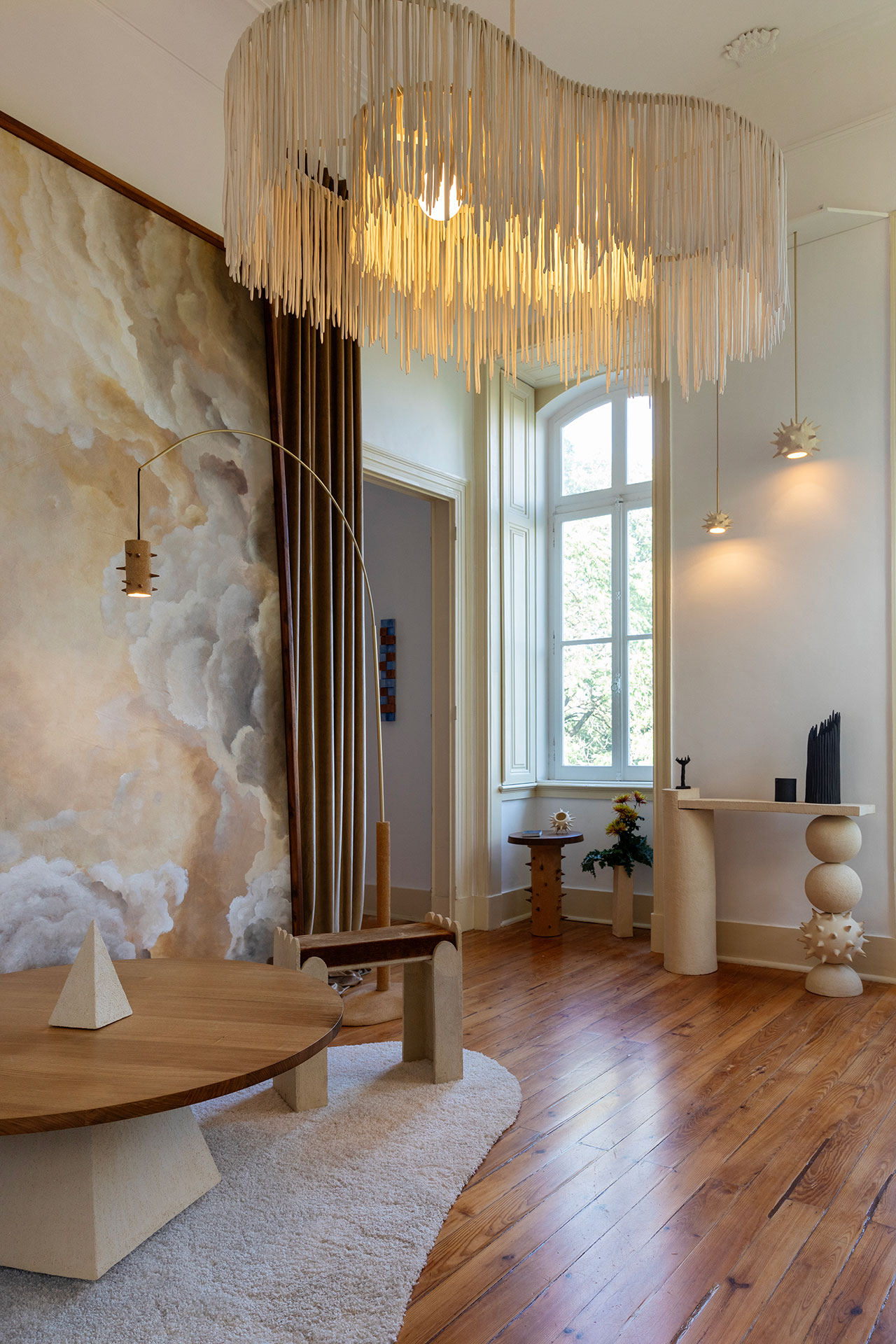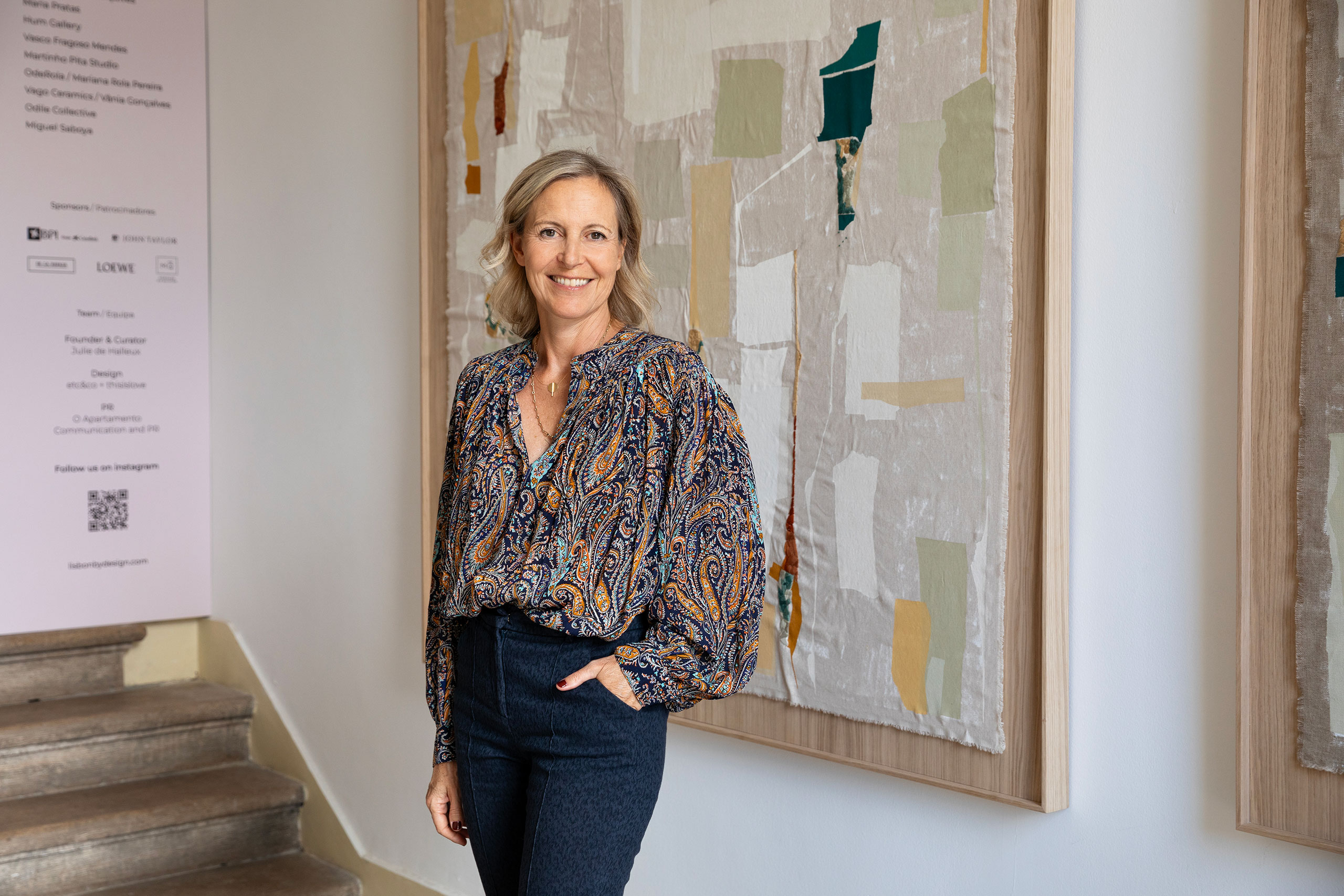Title
Lisbon by DesignDuration
23 May 2024 to 26 May 2024Location
| Detailed Information | |||||
|---|---|---|---|---|---|
| Title | Lisbon by Design | Duration | 23 May 2024 to 26 May 2024 | Location |
98 Rua Gomes Freire 1150-085 Lisboa
Portugal |

Installation view. Lisbon by Design, Palacete Gomes Freire, Lisbon. May 22- 26, 2024. Photography by Claudia Rocha.
"Interlocking Landscapes" installation featuring ceramic pieces by Vânia Gonçalves (Vago Ceramics) in dialogue with textile pieces by Mariana Rola Pereira (Oderola).

Installation view. Lisbon by Design, Palacete Gomes Freire, Lisbon. May 22- 26, 2024. Photography by Claudia Rocha.
Handcrafted furniture by Miguel Saboya; Textiles by Odile Collective.
Four years ago, Julie stood relatively alone in her determination to provide Made in Portugal with an international platform. Since then, Lisbon by Design has had a significant impact, spawning numerous initiatives, riding the wave of momentum. Leading among them is the second edition of Lisbon Design Week, which Julie helped to create—a citywide initiative with exhibitions in local museums and galleries, special installations in showrooms and shops, and lectures, tours, demonstrations, and performances in hotels, restaurants, and other unusual locations.
Emphasizing authenticity, human scale, spontaneity, quality, and local materials, both events enhance Lisbon's global standing as a city of makers as well as highlight the city’s rapid rise as a vibrant creative hub. With a flourishing hospitality and gastronomy scene, and thriving sectors such as art and architecture, it’s clear why Lisbon is becoming a favorite destination for discerning international quality seekers. What this means is that the city is transforming under the impetus of creativity, which has become a vital economic engine in a country with limited industry and natural resources.
Lisbon by Design offers a generous glimpse into Lisbon as a microcosm of diverse talent and an ideal platform to explore a curated selection of the rich creative tapestry that Portuguese design has to offer. Think about it next May when you plan a city trip! For now, here is a selection of works on display at Lisbon by Design that caught our eye.

Installation view. Lisbon by Design, Palacete Gomes Freire, Lisbon. May 22- 26, 2024. Photography by Claudia Rocha.
Atelier Daciano da Costa, re-edition of graphic signage panels originally designed for Lisbon’s Hotel Penta.

© Atelier Daciano Da Costa, Ferreira De Sá.
Daciano da Costa and Amande Haeghen
Daciano da Costa (1930-2005) was one of the pioneers of industrial design in Portugal, yet he remains relatively unknown overseas despite collaborations with among others Oscar Niemeyer and Rem Koolhaas, and his works being featured in the Centre Georges Pompidou, MoMA and the Vitra Design Museum. Originally a painter, da Costa later ventured into the fields of interior, industrial, furniture and urban design. Atelier Daciano da Costa now continues his legacy by re-issuing da Costa’s classic pieces under the help of his daughter Inês Cottinelli.
Da Costa’s graphic works, particularly the vibrant and colourful re-editions of the floor identification panels he created for Lisbon’s Hotel Penta, were prominently displayed at Lisbon by Design alongside French ceramicist Amande Haeghen’s ceramic luminaires, inspired by Portugal's wild nature and vast landscapes. Amande, who lives and works in Lisbon, uses recycled glass inside the ceramics, giving them the robust fragility that comes from combining glass and earth.

Installation view. Lisbon by Design, Palacete Gomes Freire, Lisbon. May 22- 26, 2024. Photography by Claudia Rocha.
Left: Atelier Daciano da Costa, re-edition graphic signage panels originally designed for Lisbon’s Hotel Penta. Right: Amande Haeghen, sculptural installation inspired by the archipels between Faro and Olhao in the south of Portugal

Daciano da Costa (1930-2005) © Atelier Daciano Da Costa.

Inês Cottinelli, founder of Atelier Daciano da Costa © Atelier Daciano Da Costa, Estudio Peso.
Pareidólia and Azure
Known for blending ceramics and textiles with a cohesive colour palette, this collaborative duo who share a studio in Lisbon showcased new creations incorporating upcycling and reuse.Lisbon-based Bhya Sugai, the Brazilian artist and designer behind Azure, showcased her “Heaven and Earth” series, using materials such as organic fabric, acrylic paint, embroidery and concrete, while Portuguese designer and fonder of Pareidólia, Tatiana Ferreira, artfully demonstrated the idea that objects have the innate power to enhance their user's mood through form and function.

Architect and interior designer Tatiana Ferreira, founder of Pareidólia © Pareidólia.

Architect and interior designer Tatiana Ferreira, founder of Pareidólia © Pareidólia.

Installation view. Lisbon by Design, Palacete Gomes Freire, Lisbon. May 22- 26, 2024. Photography by Claudia Rocha.
"Playground" series by Pareidólia (Tatiana Ferreira) including tile panels and stoneware lamps; "Heaven and Earth" textile series by Azure (Bhya Sugai).

"Heaven and Earth" textile series by Azure © Azure.

Artist and textile designer Bhya Sugai, founder of Azure © Azure.

Artist and textile designer Bhya Sugai, founder of Azure © Azure.
Burel Factory is renowned for its acoustic textile wall panels, as applied, among others, in Lisbon’s fashion and design museum MUDE, and now increasingly for its furniture and interior design. At Lisbon by Design, the brand showcased its new projects, including lamps and furniture. Embracing a strict zero-waste policy, Burel utilizes sustainable, handmade, traditional materials such as wool from sheep which freely graze in the northern region Serra da Estrela, Burel, ensuring ecological and high-quality products that proudly represent Portuguese mountain heritage in a contemporary way.

Installation view. Lisbon by Design, Palacete Gomes Freire, Lisbon. May 22- 26, 2024. Photography by Claudia Rocha.
Acoustic panels by Burel Factory.

Installation view. Lisbon by Design, Palacete Gomes Freire, Lisbon. May 22- 26, 2024. Photography by Claudia Rocha.
Acoustic panels and furniture by Burel Factory.

Installation view. Lisbon by Design, Palacete Gomes Freire, Lisbon. May 22- 26, 2024. Photography by Claudia Rocha.
Handmade crochet lamps by Ana Paula Almeida.
Ana Paula Almeida from Covilhã in northern Portugal is not only a university professor in the sciences but also the owner of a small yet interesting brand with a unique ambition and history. At Lisbon by Design, she presented the brand’s handmade crochet lamps which are made using wool yarns originally produced in the 1970s. The lamps are conceived as an homage to the female workers of the historic Júlio Afonso wool factory in Covilhã, which ceased operations in 2002 and now houses Ana Paula’s workshop as well as serves as a cultural hub including, with each piece given a different female name.
The crochet technique thar Ana Paula employs is very typical in Portugal and is still practiced throughout the country—the most well-known application being in the work of contemporary artist Joana Vasconcelos, who introduced this traditional crochet form into the art world—which positions her work at the intersection of innovation, heritage and sustainability

Installation view. Lisbon by Design, Palacete Gomes Freire, Lisbon. May 22- 26, 2024. Photography by Claudia Rocha.
Handmade crochet lamps by Ana Paula Almeida.

Textile artist Ana Paula Almeida © Ana Paula Almeida.

"Áurea" handmade crochet lamp by Ana Paula Almeida © Ana Paula Almeida.
Vago Ceramics and Oderola
Mariana Rola Pereira, the artist and textile designer behind Oderola, uses the ancient Portuguese Arraiolos stitch in her work to narrate stories (“Embroidery is like painting with yarn,” she says), while ceramic artist Vânia Gonçalves, founder of Vago Ceramics, crafts sculptural pieces that organically twist and fold like fabric. Inspired by nature, Vânia predominantly allows the clay to shape itself, using moulds only occasionally.
Especially designed for Lisbon by Design, their collaborative installation combines ceramic and textile elements inspired by themes of time, change and evolution. Aptly titled "Interlocking Landscapes", it brings together ceramic sculptures and tapestries made from jute (canvas used for the Arraiolos stitch), the latter covered with plaster, and stained with natural pigments.

Hand-stiched tapestry by Oderola © Mariana Rola Pereira - Oderola.

Hand-stiched tapestry by Oderola © Mariana Rola Pereira - Oderola.

Ceramic artist Vânia Gonçalves, founder of Vago Ceramics © Vago Ceramics.

Ceramics by Vânia Gonçalves - Vago Ceramics © Vago Ceramics.
Viúva Lamego is a Portuguese brand famous for its ‘azulejos’ (traditional Portuguese tiles) and its iconic tile contributions to public art and architecture, as demonstrated by their production of thousands of ceramic tiles for Joana Vasconcelos’ Wedding Cake at the Rothschild Foundation.
For Lisbon by Design, the brand celebrated its 175th anniversary with new works by Portuguese artist Bela Silva and French designer Noé Duchaufour-Lawrance. These well-known creatives both aim to honour Portuguese crafts, combining traditional artisanal techniques with modern innovation and contemporary design. Noé Duchaufour-Lawrance presented “Azulejos landscape”, a tiled triptych depicting the ocean and waves, part of his "Azulejos" collection for Made in Situ.

Installation view. Lisbon by Design, Palacete Gomes Freire, Lisbon. May 22- 26, 2024. Photography by Claudia Rocha.
Sculpture by Bela Silva for Viúva Lamego.

Installation view. Lisbon by Design, Palacete Gomes Freire, Lisbon. May 22- 26, 2024. Photography by Claudia Rocha.
Ceramic tiled triptych by Noé Duchaufour-Lawrance; tiles by Viúva Lamego, from "Azulejos" series for Made in Situ.
Carlos Manuel Gonçalves creates playful, monster-like ceramic figures brimming with humour and whimsy. He is inspired by the vibrant folk culture of Portugal's Alentejo region, where he grew up, a region where animals, people and mythical creatures still coexist in the same folk universe. His work continues the strong Portuguese tradition exemplified by among others Bordallo Pinheiro and Júlia Côta. Carlos Manuel Gonçalves' Monstruarium at Palacete Gomes Freire was filled with fantastic creatures and whimsical characters that couldn’t help but make us smile.

Installation view. Lisbon by Design, Palacete Gomes Freire, Lisbon. May 22- 26, 2024. Photography by Claudia Rocha.
Ceramics by Carlos Manuel Gonçalves.

Artist and designer Marie-Laure Davy, founder of Studio Ēeme © Marie-Laure Davy.

Ceramic artwork by Studio Ēeme © Marie-Laure Davy.

Ceramic artwork by Studio Ēeme © Marie-Laure Davy.
These two multidisciplinary creators have shared neighboring studio at the artists’ community Maria16 in Lisbon for years, both creating well-designed, sustainable and locally sourced pieces.
Sebastião Lobo is a jewellery designer who works with wire, common metals, and various organic materials such as wood, clay and fabric, as well as more noble materials like brass, copper and gold. Besides designing jewellery as well as wall sculptures, he also creates cutlery for hotels and restaurants. João Maria Bernardino, founder of ApeWood is, among other things, a woodworker who uses recycled wood to create unique pieces that strive to be modern, raw and brutal yet elegant and clean.
Their collaborative installation for Lisbon by Design imagined a dinner for Vikings, blending metalwork, woodwork and glass, showcasing organic yet elegant design. Glassware by Lucie Claudia was added to the tablescape for overall effect.

Installation view. Lisbon by Design, Palacete Gomes Freire, Lisbon. May 22- 26, 2024. Photography by Claudia Rocha.
Dining table from recycled wood by ApeWood (João Maria Bernardino); Metal plates and cutlery by Sebastião Lobo; Glassware by Lucie Claudia.

Installation view. Lisbon by Design, Palacete Gomes Freire, Lisbon. May 22- 26, 2024. Photography by Claudia Rocha.
Metal plates and cutlery by Sebastião Lobo; Glassware by Lucie Claudia.

Handmade cutlery by Sebastião Lobo © Sebastião Lobo.

Jewellery designer, sculpture and visual artist Sebastião Lobo © Sebastião Lobo.

Handcrafted table by ApeWood. Photography by Tessy Morelli.

Handcrafted bench by ApeWood © ApeWood.

João Maria Bernardino, founder and designer of ApeWood. Photography by Jonas Schilders.
Odile Collective and Miguel Saboya
Marie-Eve MacGoey’s lifestyle brand Odile Collective translates the work of Portuguese artisans who continue to master traditional techniques into contemporary textile and ceramic pieces. Lisbon-based Brazilian designer Miguel Saboya creates contemporary, intelligent, sustainable, handcrafted pieces of furniture using traditional woodwork and joinery techniques. Known for his beautiful yet discrete aesthetics and strong commitment to sustainability, including upcycling, Miguel created the interior and furniture for Lisbon’s zero-waste restaurant SEM, elevating undervalued materials to high-end pieces. For Lisbon by Design, Miguel designed a bench, incorporating textiles from Odile Collective.

Installation view. Lisbon by Design, Palacete Gomes Freire, Lisbon. May 22- 26, 2024. Photography by Claudia Rocha.
Handcrafted furniture by Miguel Saboya; Textiles by Odile Collective.

Designer Miguel Saboya in his workshop. Photography by Jody Daunton.

Designer Miguel Saboya. Photography by Jody Daunton.

Escadeira by Miguel Saboya. Photography by Kate Villevoye.
HUM Gallery, Martinho Pita and Barracão
Curated by HUM interior design gallery, "Contamination" was the revelation of Lisbon by Design. Blending wood and glass, the installation was crafted by architect Vasco Fragoso Mendes, founder of design studio Barracão, and designer Martinho Pita in collaboration with artisanal glass blowers. Carla Radoll and Bruno Graça, the dynamic duo behind the HUM gallery, firmly believe in the magic of collaboration, and their innovative installation beautifully exemplifies this belief, demonstrating how combined creative talents can push the boundaries of design and craftsmanship.
Exploring the theme of contamination, each participant's work was integrated into the other's in a visual dialogue where each piece influences the next, each change contaminates the next, creating unexpected beauty. This collaborative effort earned Vasco Fragoso Mendes the Sustainable Design Prize from Lisbon by Design’s sponsor Morgado do Quintão. The entire "Contamination" experience brought to life by the two designers, a glass artist, and a gallery, was of such a high international standard that we’re sure that it is destined to tour other such events around the world.

Installation view. Lisbon by Design, Palacete Gomes Freire, Lisbon. May 22- 26, 2024. Photography by João Guimarães.
"Contamination". Installation curated by interior design gallery HUM showcasing work by Vasco Fragoso Mendes (carpenty) and Martinho Pita (glasswork).

Installation view. Lisbon by Design, Palacete Gomes Freire, Lisbon. May 22- 26, 2024. Photography by Claudia Rocha.
Martinho Pita's artwork as part of "Contamination", an installation curated by interior design gallery HUM.

Designer Martinho Pita. Photography by João Guimarães.

Installation view. Lisbon by Design, Palacete Gomes Freire, Lisbon. May 22- 26, 2024. Photography by João Guimarães.
Martinho Pita's artwork as part of "Contamination", an installation curated by interior design gallery HUM.

Installation view. Lisbon by Design, Palacete Gomes Freire, Lisbon. May 22- 26, 2024. Photography by Claudia Rocha.
"Contamination". Installation curated by interior design gallery HUM showcasing work by Vasco Fragoso Mendes (carpenty) and Martinho Pita (glasswork). Bespoke tufted rug by Ferreira de Sá.

Installation view. Lisbon by Design, Palacete Gomes Freire, Lisbon. May 22- 26, 2024. Photography by Claudia Rocha.
"Contamination". Installation curated by interior design gallery HUM showcasing work by Vasco Fragoso Mendes (carpenty) and Martinho Pita (glasswork). Bespoke tufted rug by Ferreira de Sá.

Corcho Collection by Barracão studio (Vasco Fragoso Mendes).
Charred Oak and Cork sideboard.
150 x 40 x 50cm.
2023
© Barracao.

Detail, Barracão studio (Vasco Fragoso Mendes) © Barracao.

Designer Vasco Fragoso Mendes, founder of Barracão studio © Barracao.

"Stich Up" by Barracão studio (Vasco Fragoso Mendes).
Seating Bench/Sideboard.
200 x 45 x 45cm.
French Oak
2022.
© Barracao.

Wall Lamp 04 by Barracão studio (Vasco Fragoso Mendes).
200 x 12 x 4cm.
© Barracao.

© HUM Gallery.

Carla Radoll and Bruno Graça, founders of HUM Gallery © HUM Gallery.
Originally a French marine officer, Lisbon-based designer and ceramist Alan Louis is a rising star who creates artisanal furniture and objects ranging from benches, tables, and consoles to lamps, vases, and candlesticks. For Lisbon by Design, he presented his new collection; artfully combining chamotte sandstone and wood through pieces that challenge traditional codes and preconceived ideas, bringing opposites together to create duality. Mixing minimalism with unexpected embellishments, the pieces on display stood out for their poetic, free, and simple nature. With an upcoming show this summer at Villa Noailles during Design Parade Hyères 2024 (from June 27 to August 30), Alan Louis is definitely a name to follow.

Installation view. Lisbon by Design, Palacete Gomes Freire, Lisbon. May 22- 26, 2024. Photography by Claudia Rocha.
Furniture and lighting by Alan Louis.

Installation view. Lisbon by Design, Palacete Gomes Freire, Lisbon. May 22- 26, 2024. Photography by Claudia Rocha.
Furniture and lighting by Alan Louis.

Draughtsman, designer and ceramist Alan Louis. Photography by 20ofmarch.

Julie de Halleux, Lisbon by Design curator and founder. Photography by Claudia Rocha.

De La Espada at Ojo Gallery, Lisbon Design Week 2024.
Photo by Yuki Sugiura.

De La Espada at Ojo Gallery, Lisbon Design Week 2024.
Photo by Yuki Sugiura.
About our guest contributor Veerle Devos (Vos)
Veerle Devos, known as ‘Vos,’ is a Belgian-born historian, journalist, and urban explorer with a background in writing for international magazines. Now based in Portugal, she is the founder of LISBONEYE, an independent travel guide. Blending her love for history, cities, people, and travel, she has been organizing unique city tours since 2012, uncovering and sharing the city's hidden gems. She is also the author of ‘To Die For Portugal’, an artistic travel guide.”














